|
How much does my horse weigh?
How do I accurately work it out?
Body condition scoring is used extensively as
an aid in management of sheep and cattle. Research in horses has shown
that condition scoring provides a useful method of monitoring body
condition. Body condition ("fatness") is the most reliable indication
of the suitability of a horse's diet. Accurate estimation of a horse's weight is an
art that requires a lot of experience and even experienced horse
handlers often make substantial errors. Weight estimation is necessary
for dietary management, monitoring growth, and correct dosage of worm
treatments and other drugs.
If you have access to scales suitable for
weighing horses, these should be used on a regular basis to monitor
growth, health and fitness. If not, you will have to rely on the
methods of weight estimation outlined below.
Condition Scoring
To estimate your horse's condition
1. Assess, visually and by feel, the horse's
pelvis and rump, back and ribs and neck
2. Give those areas individual scores.
Intermediate assessments can be given half scores
3. Using the pelvic and rump assessment as
the base, adjust that score by a half point if it differs by one or
more points from the neck or ribs score
4. Height measurement should be performed on
level ground when the horse is relaxed and standing squarely. Use the
highest point of the withers as the measuring site.
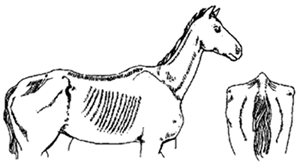 |
0 Very Poor
Very sunken rump, deep cavity under tail, skin tight over bones,
very prominent backbone & pelvis and marked ewe neck
|
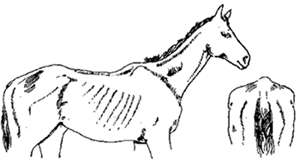 |
1 Poor
Sunken rump, cavity under tail, ribs easily visible, prominent
backbone & croup, ewe neck - narrow & slack |
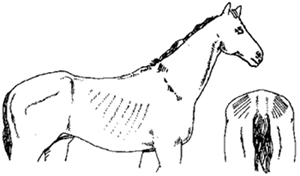 |
2 Moderate
Flat rump either side of backbone, ribs just visible, narrow but
firm neck & backbone well covered.
|
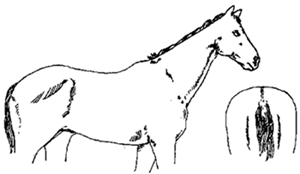 |
3 Good
Rounded rump, ribs just covered but easily felt and no crest,
firm neck
|
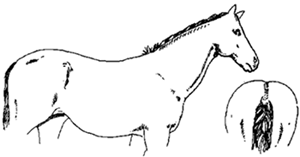 |
4 Fat
Rump well rounded, gutter along back, ribs and pelvis hard to
feel and slight crest
|
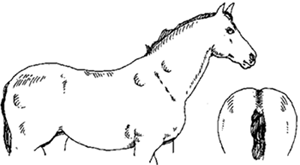 |
5 Very Fat
Very bulging rump, deep gutter along back, ribs buried, marked
crest fold and lumps of fat
|
Figure 1 Body Condition Scoring
System
Estimating weight using Height and
Condition Score
A horse's weight can be predicted using
its height (in hands) and its condition score (Table 1).
Condition
Height (hands)
Score 12H 13H
14H 15H 16H
Weights in kg
1 190 240
310 390 420
2 210 285
330 420 470
3 250 345
395 460 505
4 300 370
460 535 570
5 360 460
540 610 670
Table 1. Prediction of weight
utilising height and condition score
More accurate weight estimation can be achieved using
a nomogram as shown below in Figure 2.
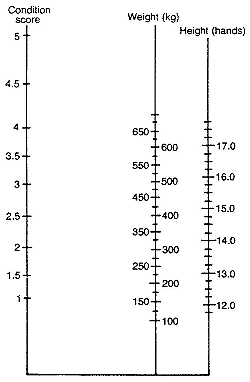 |
Figure 2.
Nomogram for estimation of liveweight from condition score and
height measurement.
A ruler is used to connect the appropriate
values of condition score and height scales, and the weight is
read where the ruler intersects the weight scale. |
Estimating weight using
measurement of girth and length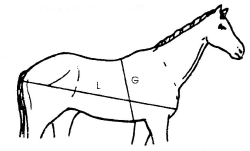
The most accurate method of weight estimation uses girth and length.
Measure the horse's girth and length as shown in
Figure 3.
Take the measurements in centimetres.
Figure 3 Measurements of girth and length
These measurements can be used with the
nomogram (Figure 4) to estimate the horse's weight.
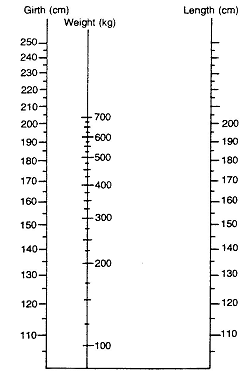 |
Figure 4.
Nomogram for estimation of liveweight using girth and length
measurements.
A ruler is used to connect the appropriate values
on the girth and length scales, and the weight is read where the
ruler intersects the weight scale. |
Estimating weight using girth
measurement
Alternatively, the weight can be calculated
from the girth and measurements using the formula:
Weight (kg) =
Girth (cm) squared x Length (cm)
12,000
Article reproduced
courtesy of http://www.ker.com
_________________________________________
Want to find
out more?
Make sure you visit
"Body Condition & Assessment"
Useful Products & Services
|